Strawberries are becoming increasingly popular amongst consumers. In fact, they are so popular that many growers are expanding their cultivation, often moving away from the open field and placing their plants in protected environments instead. Existing tomato, cucumber, and other crop growers are even exploring allocating space to strawberry growth in high-tech greenhouse environments. One of the benefits that comes with such environments is the lit cultivation it allows for. At the same time, as this development is relatively new, there are still quite a few gaps in knowledge on how best lighting practices. That is why Fluence by OSRAM, together with Delphy Improvement Centre, is conducting extensive research on this topic to improve yield and fruit quality and examine the effect of lighting on shelf life. Last year, they examined what light spectra are best suited for specific growth stages. Now, they are shifting their focus to light intensity with optimized spectra. Thus, it's high time to ask some questions.
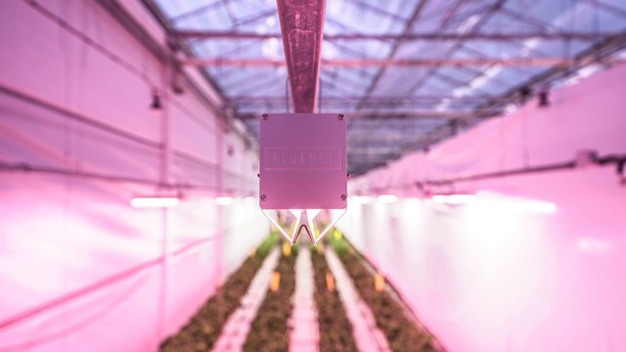
Ensuring reliable results
To better understand the best way to light strawberries, Fluence is researching extensively at Delphy’s R&D greenhouses in Bleiswijk, the Netherlands. They have planted crops in September, and they will continue until June, so they will be able to see how the crop behaves year-round.
This is the company’s second year of researching the optimal lighting strategy for growing strawberries under LEDs. Of course, as this year’s research has just started, there is not a whole lot of data to share on the subject just yet. On the other hand, last year’s trials proved very fruitful.
Leo Lansbergen, horticulture service specialist at Fluence, explains: “In the first year, when we looked into the effect of various light spectra, we had to choose which spectra to focus on. From previous research, we already knew that red-blue light is simply not the best solution for many crops. Therefore, we opted for a full white and a pink spectrum; we wanted to see the difference between these spectra.”
Haris Ouzounis, senior photobiologist and research project manager at Fluence EMEA, adds that they also knew from tomato research that a far-red spectrum may be very interesting for many crops. “So we wanted to test that far-red on a white background and on a pink background.”
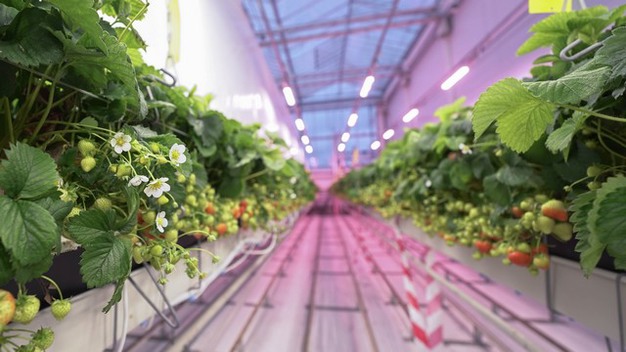

Far-red to the rescue
Besides white and pink, Fluence research also focused on far-red light. “We knew from previous research that far-red light benefits various crops, so we wanted to test that as well,” Haris said. “It’s a good thing that we did it, because we discovered that the far-red light has a positive effect on strawberries. We found, for example, that plants were more open because of the far-red light. This is beneficial not only because the plant can intercept more light in that way, but also because air ventilation in the crop becomes more effective. On top of that, labor becomes easier as well, as fruits are easier to reach and pick because of the truss elongation caused by far-red. We also saw positive effects in yields, and Brix values were higher, too.”
These are important results, especially since the effect of far-red light on strawberries is not very well-documented yet. “Yes, there is some data on its effect on tomatoes, but strawberries are a completely different crop,” Haris says. “For example, in strawberries, you have short-day varieties – they need short days and long nights to initiate flowers and grow best – whereas tomatoes are day-neutral; they need about 6 hours of darkness, but theoretically they can be lit the rest of the time. Furthermore, strawberries, especially the Junebearers, have one flush, and then it’s over, but you can harvest tomatoes year-round as they have a constant plant load. Because the crops are so different, they also have different needs when it comes to light.”
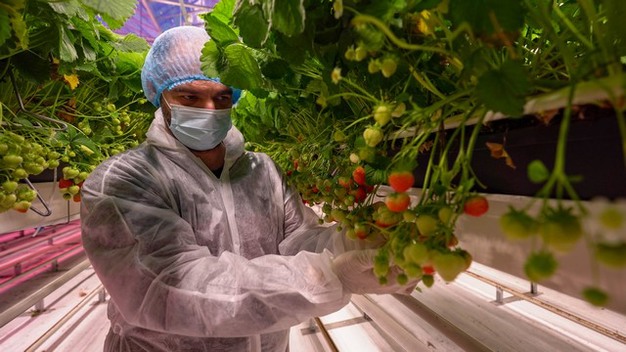
Research
It is important for researchers to leave as little as possible to chance, Leo and Haris wholeheartedly agree: “When it comes to research, we take various steps to ensure our results are not simply left to chance. First, we do research with knowledge institutes and implement proven experimental designs, typically seen in rigorous academic research. Based on these initial studies, we move on to grower trials. Only when we are confident that those are positive, too, we move on to bigger acreages,” Leo explains. Haris adds that all their research is done three-fold; each experiment is replicated three times, and the treatments are rotated too so that they can be sure none of the results they obtain are coincidental (canceling out any other environmental effects that may be influencing the crop outcome).
Leo mentions that there is another important factor they have taken into account to ensure their results are reliable. “Our research is not a joint project where we supply the lighting, and another company provides different types of substrate, and so forth. It’s a private research, so we have full control over the trial setup and observations. In that way, we can effectively measure the effect of the lights, without having to wonder whether our results vary because, for instance, the substrate was different. We can definitively say that our results were caused by the lights, making this trial a very solid one.”
Haris: “We also take into account that many plant traits are variety-dependent. To rule that out, we conduct our trials not with just one variety, but with multiple. We do that because it is important for growers to understand what happens when you have the same light spectrum or intensity and the same crop, but different varieties. No matter what variety our customers have, our research will help us help them better.”
In the research, they have taken many factors into account to ensure they get the most reliable results. One of those is the size of the research: “Normally, research is done on a relatively small scale – think about 150 or 200 m2,” Haris shares. “Our research is taking place in 1000 m2 area, separated into three smaller compartments. By so doing, our results are much more reliable and scientifically sound.”
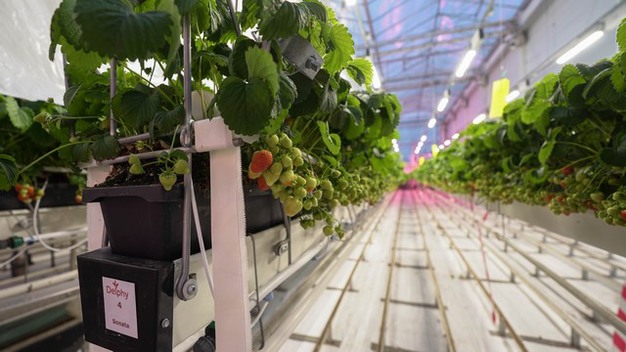
Grower trials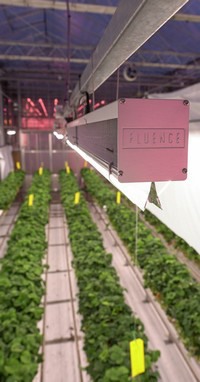 After finding these results on spectra, the Fluence team initiated grower trials. “Last year, we had a small, selected group of growers who were either already using lights in their strawberry crops or were interested in starting to do so. In that group, we found one grower who was interested in doing a trial in his own greenhouse with the spectrum that turned out to give the best result in last year's trial. Based on that research, we continued to test our findings in practice so the grower could give us comments and feedback. That way, we can fine-tune our findings further,” Leo explains.
After finding these results on spectra, the Fluence team initiated grower trials. “Last year, we had a small, selected group of growers who were either already using lights in their strawberry crops or were interested in starting to do so. In that group, we found one grower who was interested in doing a trial in his own greenhouse with the spectrum that turned out to give the best result in last year's trial. Based on that research, we continued to test our findings in practice so the grower could give us comments and feedback. That way, we can fine-tune our findings further,” Leo explains.
The grower trials are especially important as they ensure that the focus of the research remains practical. “We want to be scientific, but without losing focus on where it really happens; in the greenhouse, with the growers. That’s our dual approach. Our choices on trial setup were also based not only on literature reviews, but also on growers’ opinions. After all, these indicate what is truly important to analyze,” Leo added.
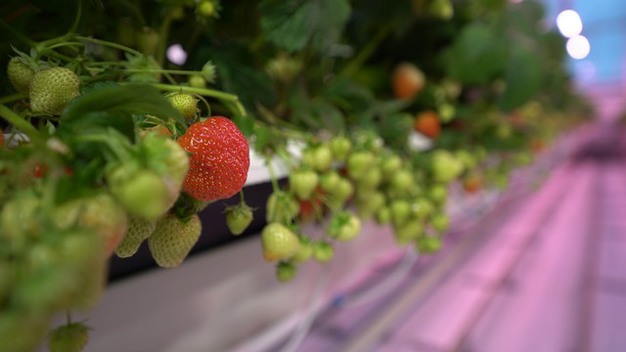
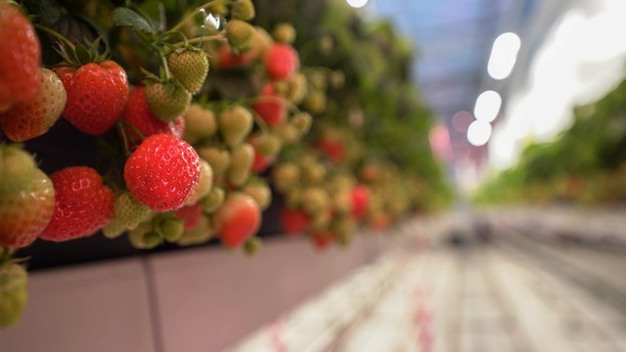
HPS and LED
With the current energy crisis, sustainability and energy efficiency are critical to consider for lit cultivation. However, Leo and Haris are convinced LED is the best way to go. “When you look at lit strawberry crops, most of it is under HPS. However, because of the higher efficiency and efficacy of LED lighting, we expect that a switch from HPS to LED might go fast, especially with the energy crisis. Investments in lighting and research are not just for the short term – they are for the next 5+ years. Such a switch might be a big investment, but it will massively save costs in the end,” Haris states.
Leo agrees that LED is the most viable option for lit strawberry cultivation, especially as strawberries prefer lower temperatures and because we expect to move toward higher light intensities in coming years. “If growers using HPS will increase light intensity, temperatures in the greenhouse will also rise. As strawberries are not the biggest fan of higher temperatures, you will not win much by increasing light intensity under HPS. With LED, however, increasing light intensity does not equal increasing temperature – or, well, that increase is so small that it can easily be managed – making it much better suited for lit strawberry cultivation.”
At this moment, the research into light intensity and its effects on strawberry crops is in progress, so we cannot share data on that just yet. Once Fluence and Delphy have concluded that research, however, we will be sure to give you an update.
 Fluence
Fluence4129 Commercial Center Drive
Suite 450 Austin, TX 78744
512-212-4544
info@fluencebioengineering.com
www.fluence.science
 Delphy
Delphy